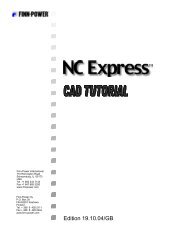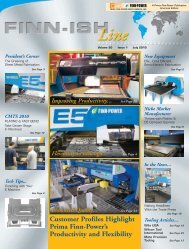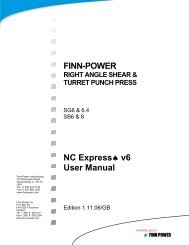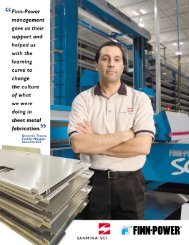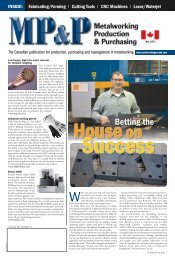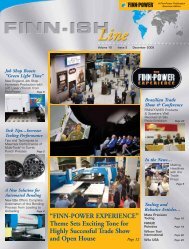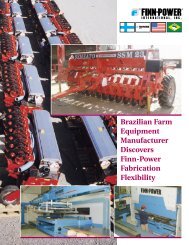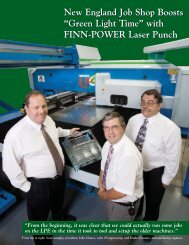Tooling Articles... Advanced Automation Enhances ... - Prima Power
Tooling Articles... Advanced Automation Enhances ... - Prima Power
Tooling Articles... Advanced Automation Enhances ... - Prima Power
You also want an ePaper? Increase the reach of your titles
YUMPU automatically turns print PDFs into web optimized ePapers that Google loves.
POWERLINE<br />
FOCUS ON<br />
TOOLING<br />
ue to improvements in quality and durability, press<br />
D brake tooling is no longer a perishable commodity.<br />
When properly cared for and used within the correct<br />
range of applications, today’s precision ground and<br />
hardened press brake tooling can often provide a usable<br />
service life of ten years or more. That is not to say that<br />
it will simply last for ten years or more, but rather, it will<br />
provide performance that is the same, or nearly the<br />
same, as it did when it was brand new and right out of<br />
the box for that long or longer.<br />
As such, when purchasing tooling for a new press brake,<br />
or updating an existing press brake with new tooling,<br />
today’s press brake tooling buyer is now more than ever<br />
making a long term decision. As with any other long<br />
term business decision, you’ll want to make the decision<br />
that will provide you with maximum productivity and<br />
the maximum return on your investment.<br />
While hardened working surfaces are critical to the<br />
performance of today’s press brake tooling, not all<br />
hardening processes are equal. At Wila, we understand<br />
that high performance brake tooling that provides<br />
maximum durability and maximum long term accuracy<br />
retention begins with the steel that the tooling is<br />
produced from. We utilize a proprietary alloy steel that<br />
we actually helped to develop. This steel is produced solely for and<br />
is available only to Wila. It provides exceptional strength, excellent<br />
ductility, extremely fine surface finishes, excellent machinability, and<br />
highly consistent deep hardening characteristics. It is used in the<br />
production of all of<br />
our New Standard<br />
Premium and<br />
American Style<br />
Punches and Dies.<br />
Photograph shows the depth of hardening achieved<br />
by Wila’s proprietary CNC-Deephardening process<br />
on an Acute-Angle Die.<br />
Maximum <strong>Tooling</strong> Performance<br />
It’s All In The Hardening Process!<br />
By David Bishop, Business Development Manager, WILA USA<br />
Photograph shows the tip of a Wila Acute-Angle Punch being CNC-Deephardened.<br />
To maximize the<br />
performance of our<br />
proprietary steel, we<br />
invested over<br />
$1-million dollars in<br />
the development of<br />
a patented hardening<br />
process that we<br />
refer to as CNC-<br />
Deephardening ® .<br />
This process provides<br />
tight tolerance CNC<br />
control over the heat<br />
up time, hold time,<br />
cooling time, and the<br />
depth of hardening.<br />
The combination of<br />
our proprietary steel and our patented CNC-Deephardening process<br />
enables us to provide our New Standard Premium and American<br />
<strong>Tooling</strong> lines with working surfaces that are hardened to HRC 56-60 to<br />
a depth of .157” (4.0mm), making them the most durable lines of press<br />
brake tooling available.<br />
While high performance press brake tooling depends on the optimum<br />
combination of steel and hardening process, these elements also serve<br />
critical roles in terms of the safety of the tooling when it is subjected<br />
to excessive force. Experience has taught us that to provide maximum<br />
performance and maximum safety, you must address both the hardness<br />
of the working surfaces of the tooling and the core hardness of the<br />
tooling. We do this by retaining a core hardness of HRC-30 on all of<br />
our punches and dies after the CNC-Deephardening process has been<br />
applied. This prevents them from becoming brittle and potentially<br />
shattering when excessive force is applied. Anyone that has ever had<br />
the misfortune of having a press brake tool explode when it was<br />
exposed to excessive force sending fragments flying like a detonated<br />
grenade will fully understand the critical importance of this issue.<br />
In the end, not all press brake tooling is created equal, and that most<br />
definitely includes the hardening process that gives it its durability. As<br />
you invest in a tooling system for a new press brake or an existing<br />
press brake, this is something that you’ll definitely want to take into<br />
consideration.<br />
PRIMAPOWER.COM 15




